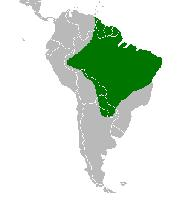
Poids et mesures
| Longueur | 60 cm |
|---|
Données biologiques
| Durée de vie | 15 r |
|---|
Statut de conservation
| Menacé |
Description de l'animal
The Toco Toucan, scientifically known as Ramphastos toco, is perhaps the most iconic and recognizable species within the toucan family, thanks to its vibrant plumage, remarkably oversized bill, and its frequent appearances in popular media and zoo exhibits around the world. This striking bird inhabits a wide range of South American environments, from the dense Amazonian rainforests to the more open savannahs and woodlands, showcasing its adaptability and resilience.One of the Toco Toucan's most distinctive features is its large, colorful bill, which can grow up to two-thirds the length of its body. Contrary to what one might expect, this seemingly cumbersome bill is surprisingly lightweight, owing to its composition of keratin (the same material that makes up human hair and nails) and a network of air sacs. This remarkable structure serves multiple purposes: it aids in thermoregulation, allowing the toucan to adjust its body temperature; it is used as an intimidating display to deter predators and rivals; and it plays a crucial role in their feeding habits, allowing them to reach and consume a variety of fruits, berries, and occasionally small birds, insects, and eggs.
The Toco Toucan's plumage is predominantly black with a white throat and chest, creating a stark contrast that is visually striking. Its eye-catching orange-yellow bill is complemented by a splash of color around the eyes, where the skin can range from blue to green, adding to its charismatic appearance. The legs are strong and grey-blue in color, supporting its arboreal lifestyle. Despite its heavy-looking bill and sizeable body, the Toco Toucan is an adept flyer, although it prefers to hop between tree branches when navigating through the forest.
Reaching up to 63 centimeters (25 inches) in length and weighing approximately 500 to 860 grams (1.1 to 1.9 pounds), the Toco Toucan is the largest species in the toucan family. Its size, however, does not deter it from engaging in social interactions. Toco Toucans are known for their playful and noisy behavior, often engaging in bill-fencing games and vocalizing a range of croaks, grunts, and chirps that contribute to the lively soundscape of their habitats.
Breeding season for the Toco Toucan involves monogamous pairs nesting in tree cavities. The female typically lays two to four eggs, which both parents then incubate. The chicks are born altricial (blind and featherless), relying entirely on their parents for food and protection until they are ready to fledge. This period of dependency fosters strong family bonds and further highlights the social nature of these birds.
Unfortunately, the Toco Toucan faces threats from habitat destruction and the illegal pet trade. Their distinct appearance makes them highly sought after as exotic pets, leading to their capture and sale, which further pressures wild populations. Conservation efforts are crucial to ensure the survival of this species, emphasizing the importance of protecting their natural habitats and enforcing laws against illegal wildlife trade.
In conclusion, the Toco Toucan (Ramphastos toco) is a fascinating bird that captivates the imagination with its vivid colors, remarkable bill, and lively behavior. It plays an important role in its ecosystem as a seed disperser, contributing to the health and regeneration of the forests it inhabits. As a symbol of the exotic beauty and biodiversity of South America, the Toco Toucan reminds us of the importance of conservation efforts to preserve the natural world for future generations.
Carte de répartition

Animaux similaires
Nouvelles photos d'animaux
Top 10 des animaux
- Dolphin gull (Leucophaeus scoresbii)
- Japanese macaque (Macaca fuscata)
- Stone loach (Barbatula barbatula)
- Greek tortoise (Testudo graeca)
- Russian tortoise (Testudo horsfieldii)
- Galápagos tortoise (Geochelone nigra complex)
- Diana monkey (Cercopithecus diana)
- Moustached guenon (Cercopithecus cephus)
- Common flying dragon (Draco volans)
- Galápagos penguin (Spheniscus mendiculus)

